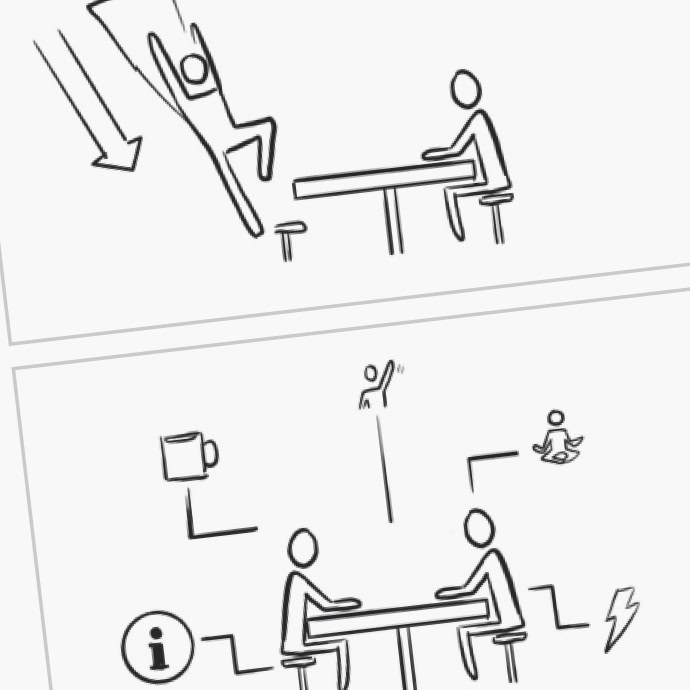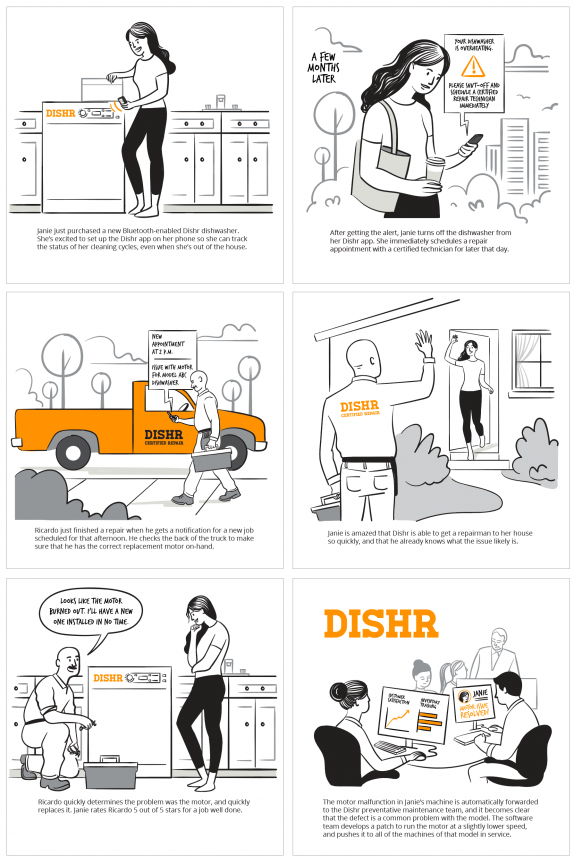Storyboarding makes big ideas manageable
BATMAN
Do you bleed?
SUPERMAN
(glares)
BATMAN
You will!
They fight.
Imagine you were directing the Hollywood movie, Batman v Superman: Dawn of Justice. Then you got to this point in the script: “They fight.”
What takes up just two words in a script represents a scene that spans 12 minutes, impacts hundreds of staff, and kicks off a multitude of decisions. Decisions that cost millions of dollars. How do you even begin to consider the scope of such a scene?
Similarly, organizations with big ideas also must find ways to wrap their heads around projects that can affect huge numbers of staff, require decisions up and down the org chart, and cost a ton of money.
So what can you do? You can start with a storyboard.
Storyboarding takes a big idea and breaks it into manageable and understandable parts, allowing you to:
- Consider every aspect of an idea, gleaning insights you may not otherwise have discovered.
- Chart out ideas and see, step by step, how they could/should work.
- Identify key audiences, teams, processes, and outcomes.
- Depict any level of specificity you want depending on the complexity.
What exactly is storyboarding?
Storyboarding involves creating a sequence of drawings depicting the action of a scene alongside written descriptions and dialog. Think of it as a comic book that resembles the lowest-cost version of the movie. All that’s required is paper and a pencil.
With a storyboard the film director can experiment with pacing, tone, visual dynamics, and story — without ever setting up a camera. It’s a low-stakes environment for finding the best way to tell the story. Something isn’t working? No problem, just erase it and start over. You wasted about 2¢ as opposed to $2 million, and you and your entire crew know exactly how and when Batman needs to duck when Superman comes zooming toward him at Mach 2.
How can storyboards be used in organizational change?
Storyboards are great at taking a big idea and making it digestible. That’s why they’re often used when mapping out movies and videos. They are in that rarest of categories where both the process of creation and its result are valuable in different ways.
As a creative effort during any organizational transformation, storyboards encourage you to imagine scenarios to their fullest, and to consider all the people, places, parts, and possibilities that might go into those scenarios. Storyboards help aid in the exercise of broad ideation as well as identify the most minute points of specificity.
- Chart out a strategic vision
- Visualize a customer experience
- Plan a roadmap
- Identify roles and responsibilities across a project
On top of that, your finished storyboard can act as a North Star by answering questions such as: “Why did we decide to do it this way?”, “Who has accountability for this phase?”, or “How do we think the customer will respond to this communication?”
A good storyboard is a cohesive visual narrative that everyone can see and reference. It eliminates ambiguity by demanding a level of specificity that generates confidence in ideas, activities, and things that might not yet exist.
A real-life example of the power of storyboarding
In our work with a consultancy for a diabetes equipment company, we used a storyboard to map out a day in the life of a caregiver with Type 1 diabetes. The process provided the product teams with a clearer picture of the caregiver’s needs — even if those needs weren’t directly related to diabetes. The storyboard created a greater sense of empathy for that person, allowing developers to provide a better product.
And the sales group within that same company wanted to develop a “buyer’s journey” to better understand how to market to them. Storyboarding unveiled specific personas, allowing them to see their sales targets as real people and consider every aspect of their decision making process.
Here’s what storyboarding looks like
Check out the example below of a storyboard created to outline the customer-friendly repair process created for DISHR, a fictitious company.
Use storyboarding to make strategic change easier to see
If you’re considering a strategic organizational change, consider starting with storyboarding to break it down into smaller, more manageable chunks. It’s a powerful, simple tool that works in any situation.
If you’d like to talk about how Tremendousness uses storyboarding to get a headstart on complex change, we’d love to hear from you.

